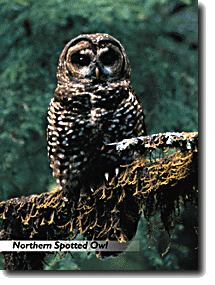Northern Spotted Owl
Status: Threatened

Species Information: To meet their biological needs, Northern spotted
owls generally require large home ranges and use large tracts of land
containing significant acreage of older forests.
Spotted owl habitat consists of four components: (1)nesting,
(2)roosting, (3)foraging, and (4)dispersal. The age of the forest is
not as important for determining suitable habitat, as is the structure
and composition of the forest. Northern interior forests typically
require 150 to 200 years to attain the attributes of nesting and
roosting habitat; however a younger forest can be suitable if there
is a significant amount of remnant trees.
Superior nesting and roosting attributes include moderate to high
canopy closure (60 to 80%); a multi-layered, multi-species canopy
with large overstory trees; a high incidence of large trees with
various deformities; large accumulations of fallen trees and other
debris; and sufficient open space below the canopy for owls to fly.
Foraging - spotted owls use a wider array of forest types for foraging,
including more open and fragmented habitat.
Environmental Impacts: Due mainly to historic timber harvest
patterns, about 75 percent of the known rangewide population of
spotted owls is centered on Federal Lands. Non-Federal lands,
in certain portions of the owl's range are still neccessary to
support and supplement the Federal lands-based owl conservation
strategy.